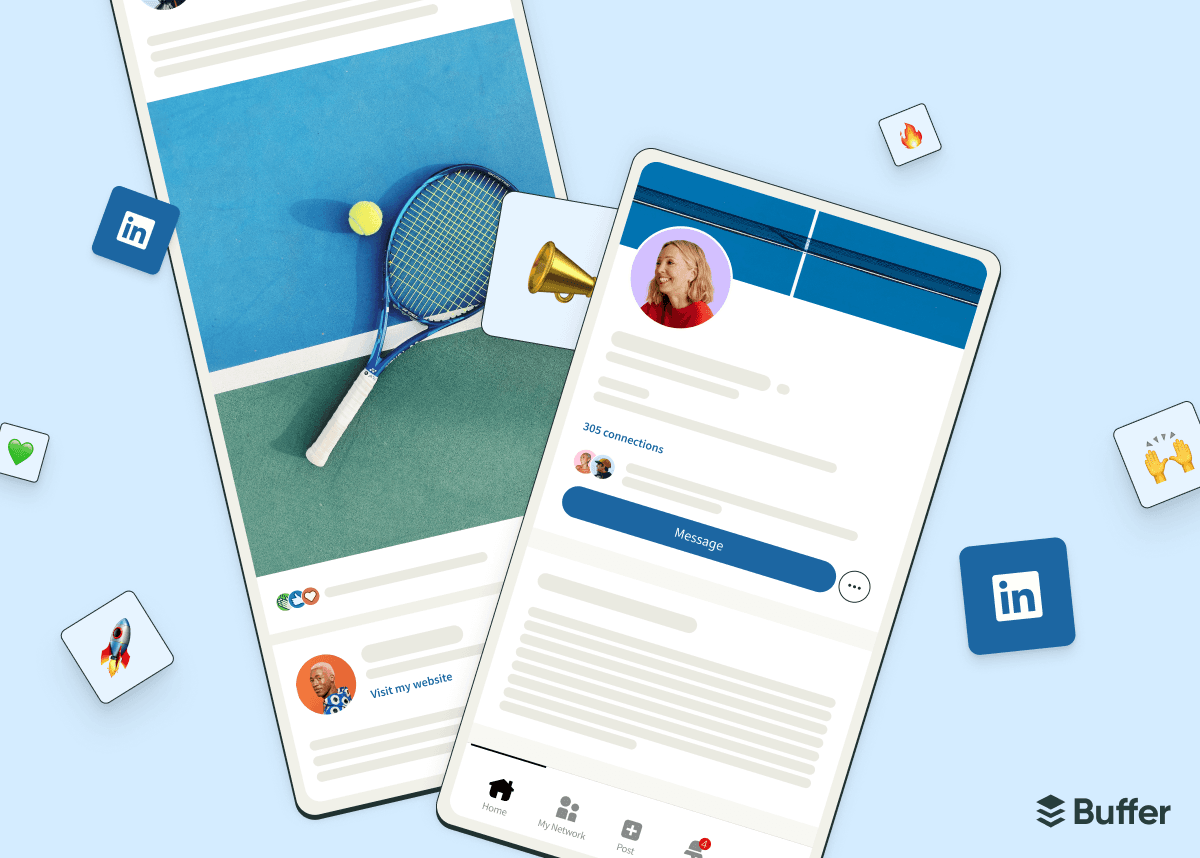As a consultant, having a flow of high-quality clients is a must for steady, sustainable business growth (and making the rent every month).
Thankfully, LinkedIn can make this a whole lot easier.
While many lead generation channels need constant investment in ads or sales (things that solo consultants often don’t have the budget for), LinkedIn offers a way to bring new clients to you.
In my three years as a consultant, I've found LinkedIn consistently delivers the highest quality leads with the least ongoing cost — once you understand how to use it effectively.
In around that time, I’ve built up an audience of 14,000 followers on LinkedIn, which has been crucial in helping me find new clients. Or rather, helping them find me.
In fact, around 80% of my 2024 clients reached out to me on LinkedIn.
Here, I’ll share my exact process for establishing myself as a trustworthy expert in my field — one that clients want to work with.
Why LinkedIn is the perfect platform for consultants
LinkedIn is still the go-to platform for professionals — particularly those with buying power.
An impressive four out of five LinkedIn members drive business decisions, so your potential audience on LinkedIn has double the buying power of the average web audience.
The platform's focus on professional networking and thought leadership creates an environment where consultants can easily showcase their expertise and build strong relationships in their industry
My journey with LinkedIn started organically. Without any sales intentions, I began posting about my experiences as a marketer to share my problems and experiences with other marketing specialists and exchange ideas.
At that time, I was working as a CMO at Hunter and just wanted to connect with other marketers in the field. What started as casual content sharing evolved when I started receiving consulting requests from viewers who resonated with my insights.
The inquiries I started getting really highlighted LinkedIn's potential as a powerful lead-generation platform — especially when the focus is on providing genuine value rather than pushing a hard sell.
Here’s exactly how I use LinkedIn to find new clients as a consultant:
1. I treat my LinkedIn profile like a sales pitch
Potential clients may come across my content on their feeds, but they’ll definitely be visiting my profile to check out my experience and skills before they consider working with me.
I see it as a step down my personal sales funnel — which is why I’ve been sure to include all these subtle, important factors:
Strong personal branding
I put a lot of time, effort, and thought into my LinkedIn personal brand. The first step in getting this right, I feel, is to have a professional, yet still friendly and approachable, profile picture.
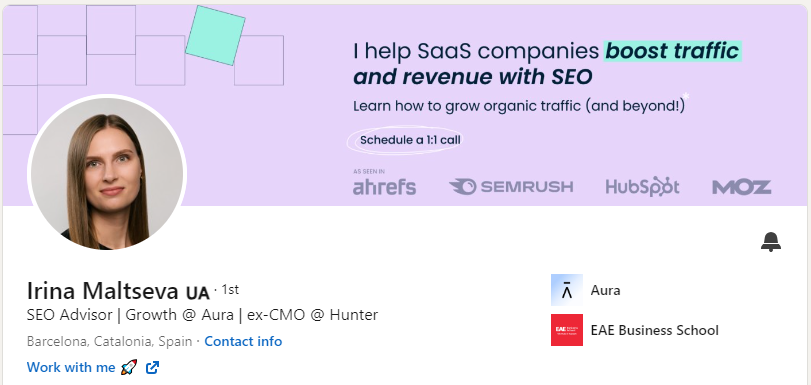
Easily contactable
Also, I've made it really easy for potential clients to contact me by prominently displaying my email address and including a clear link to schedule a call. This removes friction from the connection process and shows I'm easy to get in touch with for business discussions.
Social proof
Client recommendations form a crucial part of my profile strategy. I actively contact past clients to request specific, results-focused testimonials.
These recommendations highlight concrete outcomes and provide social proof of my expertise. Each recommendation tells a story of problems solved and goals achieved.
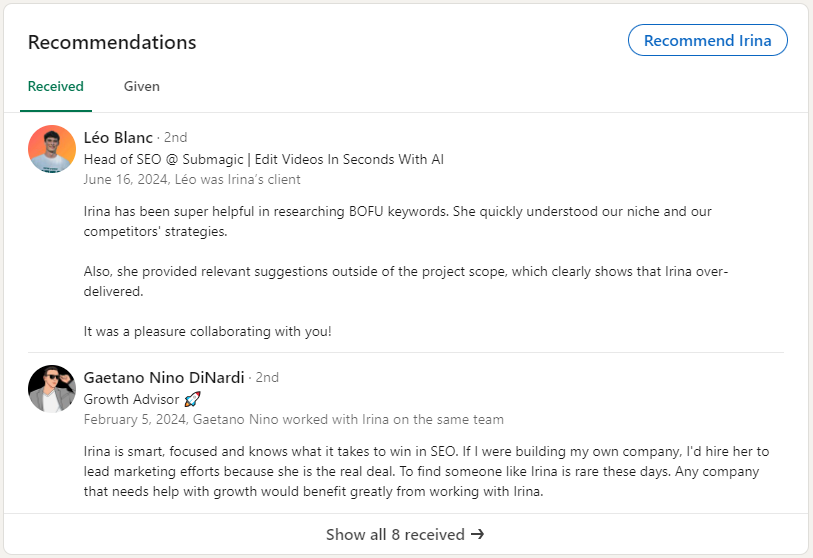
Include important details
I’ve optimized every profile section with details that matter to potential clients.
My experience section focuses on measurable results and client outcomes rather than just responsibilities.
My skills section highlights specific areas of expertise that align with client needs, backed by endorsements from industry peers.
Clear messaging
I’ve written a detailed ‘About’ section that clearly explains my services, highlights what makes my approach unique, and makes me stand out.
When writing your own, be specific about the problems you solve and the results you deliver, giving potential clients a clear picture of how you can help them succeed. Focus on addressing their pain points and the tangible outcomes they can expect from working with you.
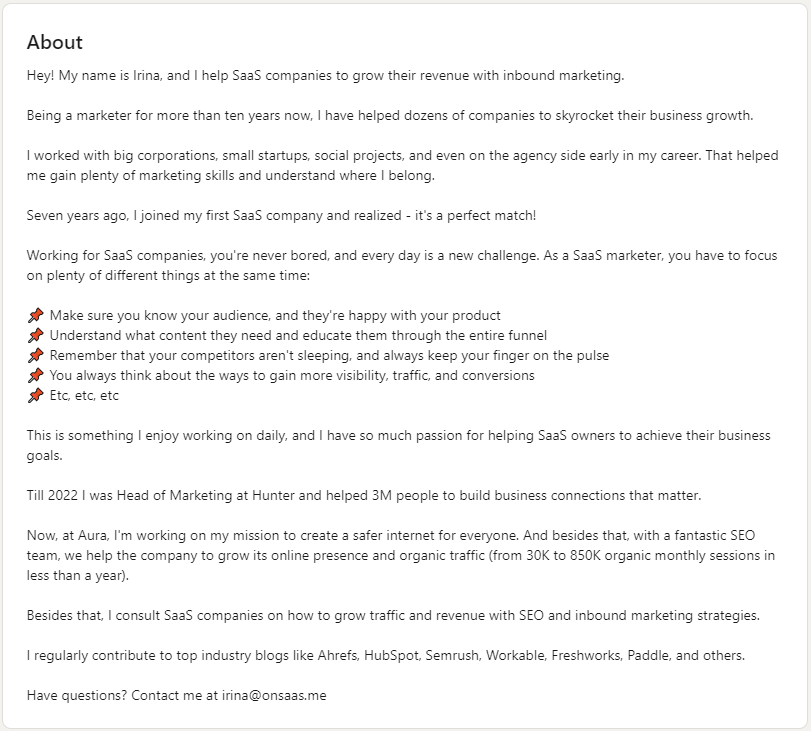
2. I build relationships on LinkedIn every day
Connecting with key decision-makers is part of my daily routine.
I identify and connect with CMOs, COOs, and founders in my target market, always sending personalized connection requests that reference shared interests or mutual connections.
Active engagement with industry leaders' content also forms a core part of my strategy. That means, when I come across posts that might tap into my skillset, I’ll share thoughtful, detailed comments that add value to discussions and demonstrate expertise. This visibility helps establish credibility with potential clients who follow these industry figures.
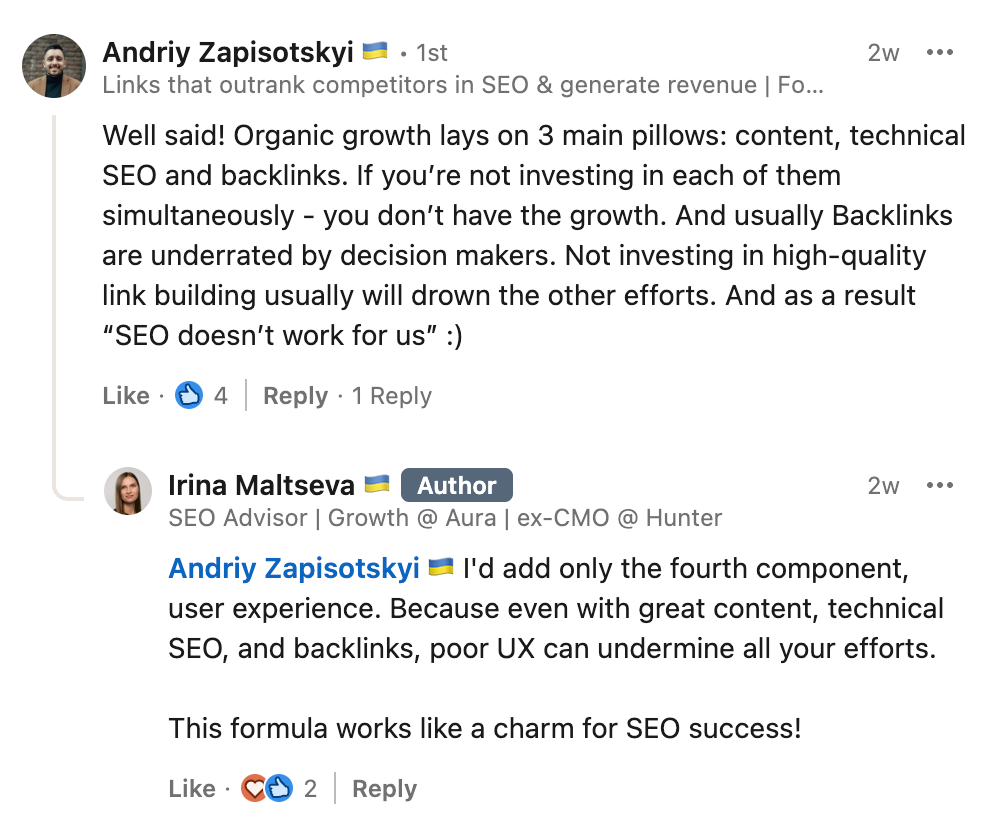
Another important factor in building these relationships is a quick response time to messages and comments. This helps keep you top of mind with potential clients.
I treat LinkedIn communications with the same priority as client emails, responding promptly during business hours. This responsiveness shows reliability and respect for others' time. When someone takes the initiative to reach out, their interest is highest at that moment, and delayed responses can mean lost opportunities.
I've found that quick and thoughtful replies often lead to immediate conversations about potential projects, while delayed responses frequently result in cold trails.
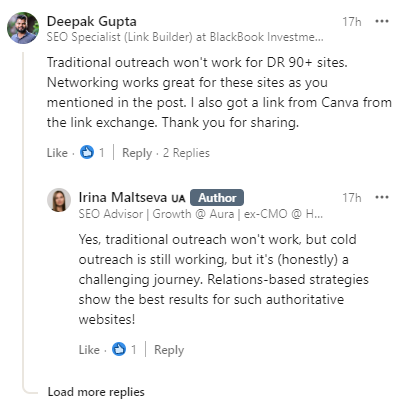
3. I share value with every post
My content strategy centers on sharing practical, actionable value without asking for anything in return.
This means posting detailed technical guides, proven frameworks, and real-world solutions from my consulting experience. I freely share tools like analytics templates, SEO templates, and marketing frameworks that others can immediately use in their work.
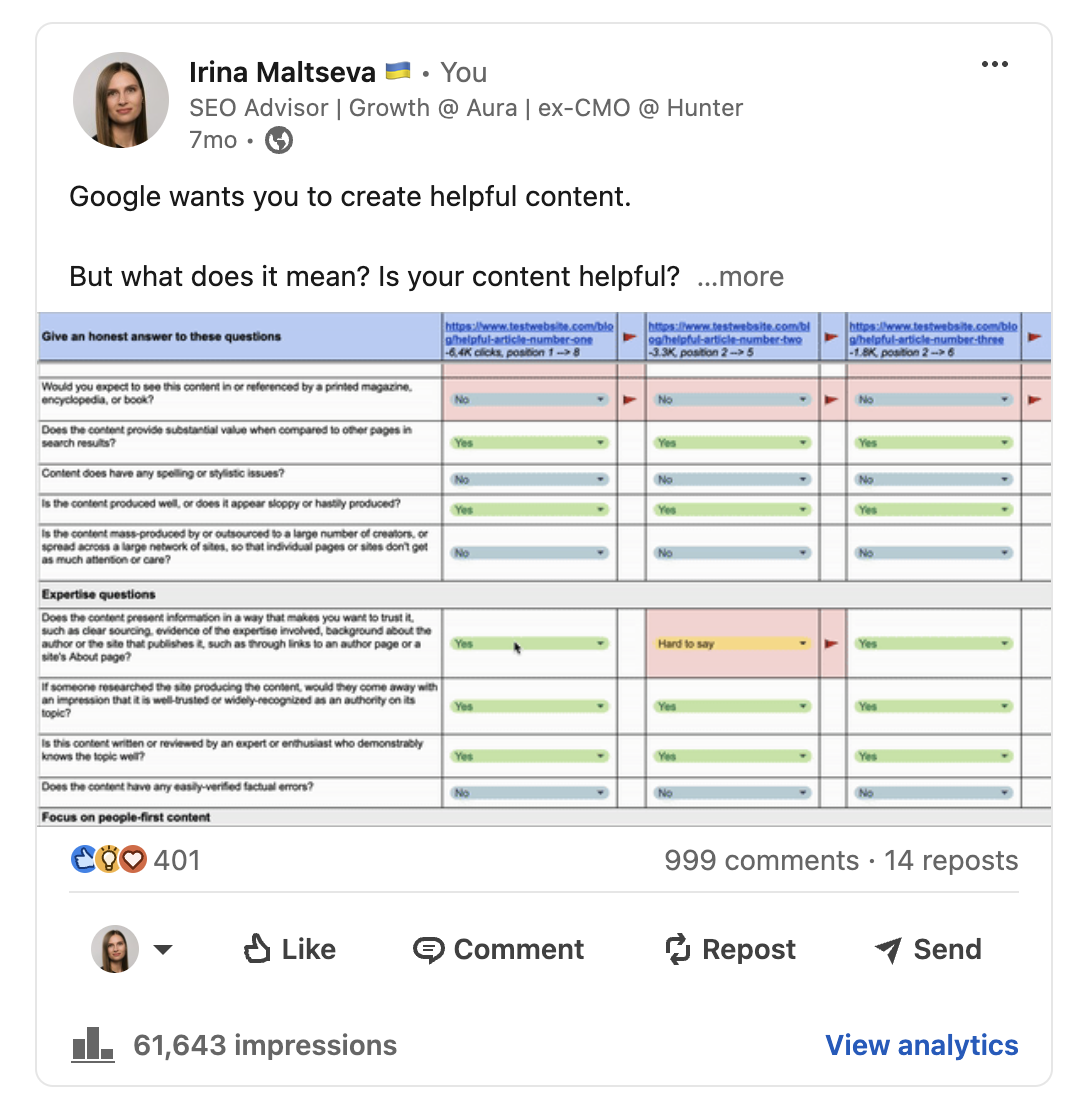
When I identify industry trends or significant market changes, I provide in-depth analysis with specific, implementable recommendations. Each post focuses on solving a concrete problem or improving a specific business process, backed by metrics and examples from actual projects.
This approach naturally establishes trust.
Many of my current clients followed my content for months, implementing my free advice, before reaching out for consulting services. They chose to work with me because they had already experienced the value of my expertise through my content.
Even during slower business periods, I maintain this focus on providing genuine value rather than self-promotion, as it consistently leads to stronger professional relationships and inbound client opportunities.
4. I do my best to post regularly
I maintain a consistent presence on LinkedIn by publishing two high-quality posts each week, typically Tuesday through Thursday mornings when my professional audience is most active.
It took me some time to find the best schedule, but after many attempts, I realized these times are perfect for connecting with my audience and boosting engagement.
Each week follows a strategic content mix: one post sharing technical insights from current consulting work, another analyzing relevant industry trends, or offering practical resources or frameworks.
This regular posting schedule keeps my profile visible and demonstrates sustained expertise in my field.
Through LinkedIn's analytics, I track which content generates the most engagement and refine my approach accordingly. While I prioritize consistency, I never sacrifice quality for quantity — I'd rather post less frequently than share content that doesn't provide real value to my network.
5. I stay focused on my niche
I concentrate solely on growth marketing for SaaS companies, specifically focusing on SEO.
Rather than commenting on general marketing trends, my content consistently addresses specific challenges in this space.
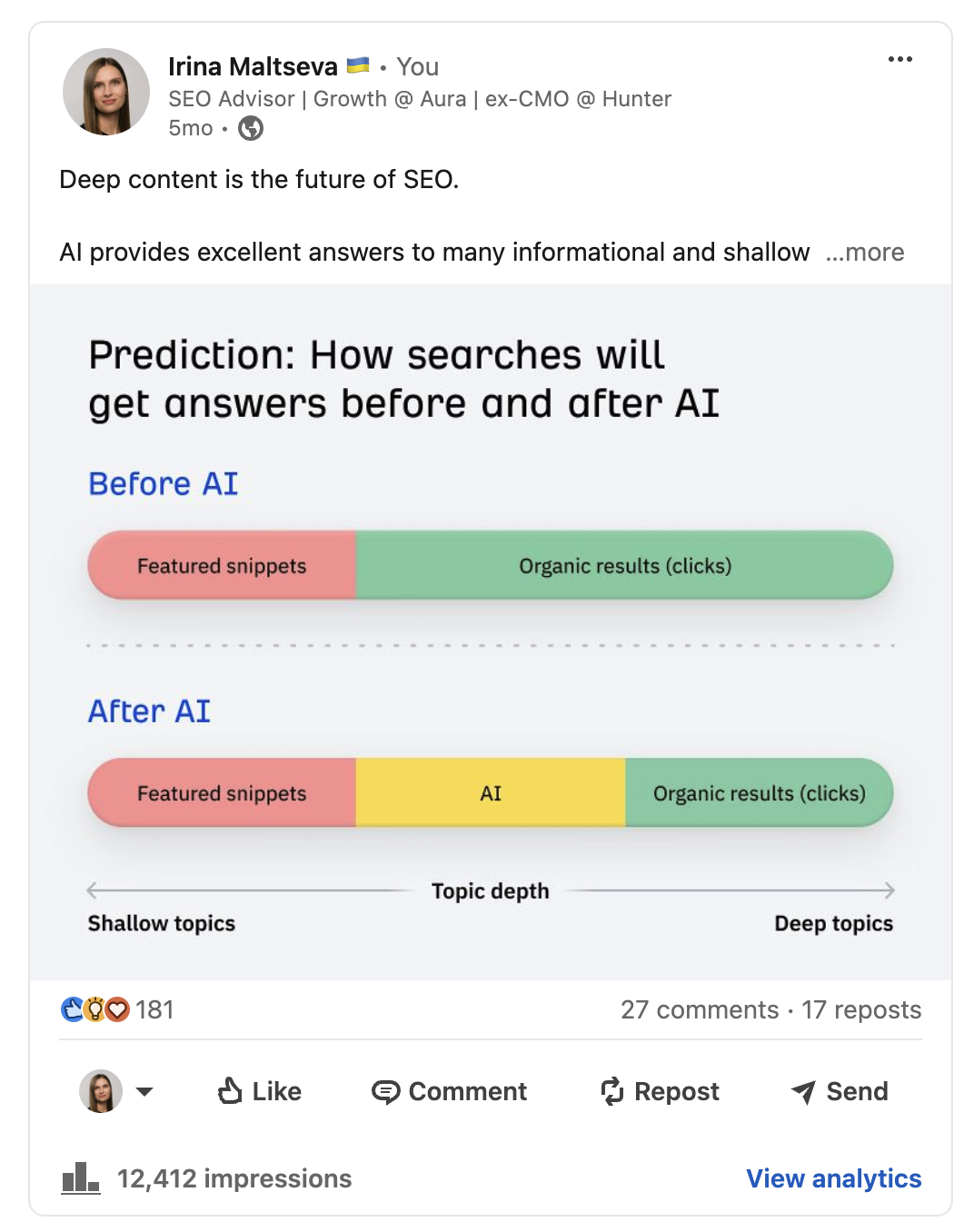
This narrow focus has established my reputation as a specialized expert rather than a generalist consultant.
When SaaS founders and marketing leaders visit my profile, they find solutions to their exact challenges, supported by relevant metrics and case studies.
By resisting the temptation to branch into other areas, even during slower periods, I've built a reliable reputation that attracts high-value clients specifically seeking SaaS growth expertise.
6. I use case studies to demonstrate my expertise
I regularly turn my consulting engagements into detailed case studies that showcase both successes and challenges. I use Canva to make my posts and carousels more visually friendly.
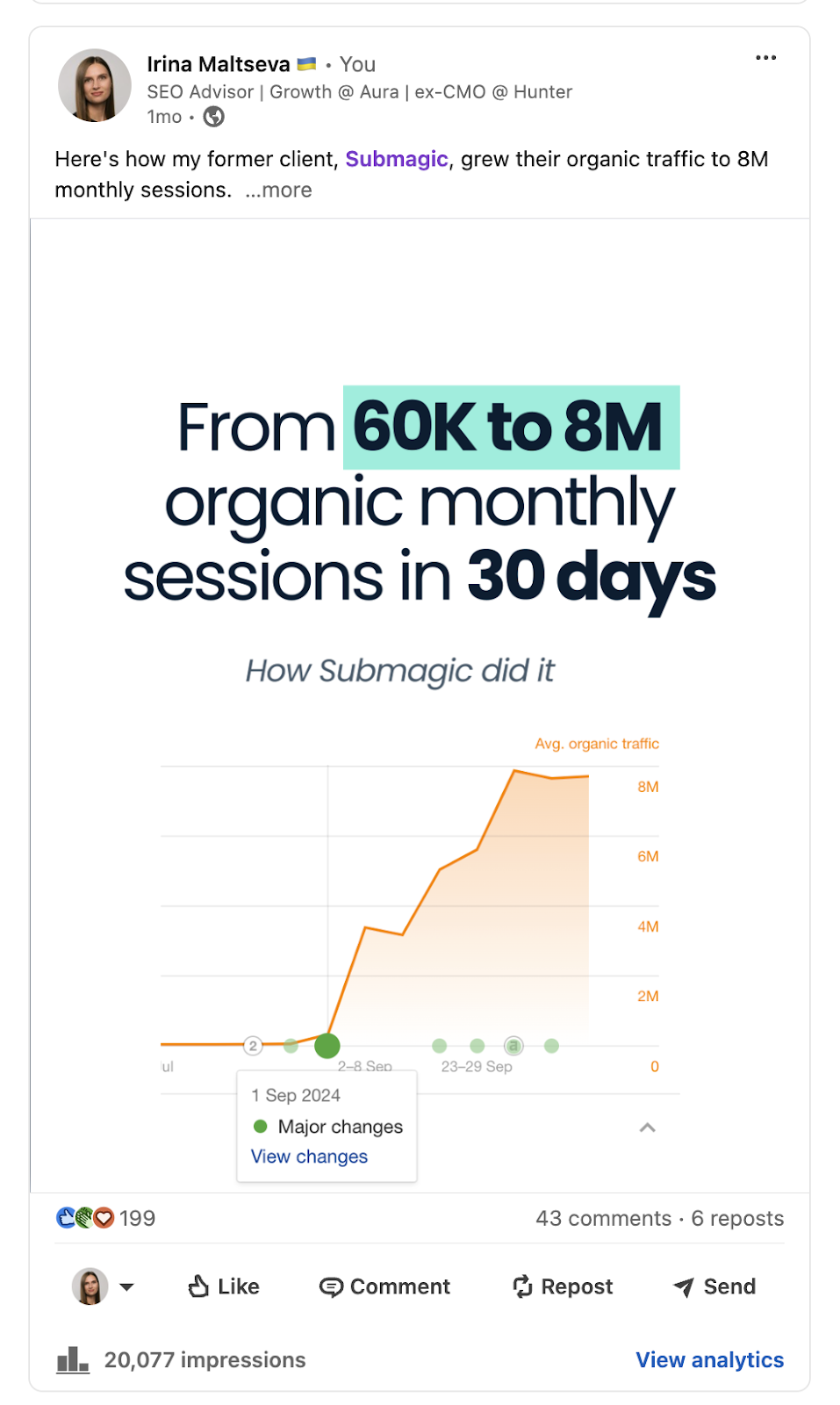
Rather than presenting polished highlight reels, I share the complete journey, including setbacks and course corrections.
Each case study follows a clear structure: the initial business challenge, our strategic approach, specific implementation steps, measurable results, and key lessons learned.
I include practical details like actual messaging examples, tool recommendations, and budget breakdowns that provide immediate value to readers. This transparent approach, showing both wins and difficulties, helps potential clients understand exactly what working with me will be like.
Here’s another great example of how to structure case studies in a simple way, by my teammate (and one of my favorite LinkedIn creators), Gaetano DiNardi. Here, he shares the exact strategy on how we grew Aura’s organic traffic:
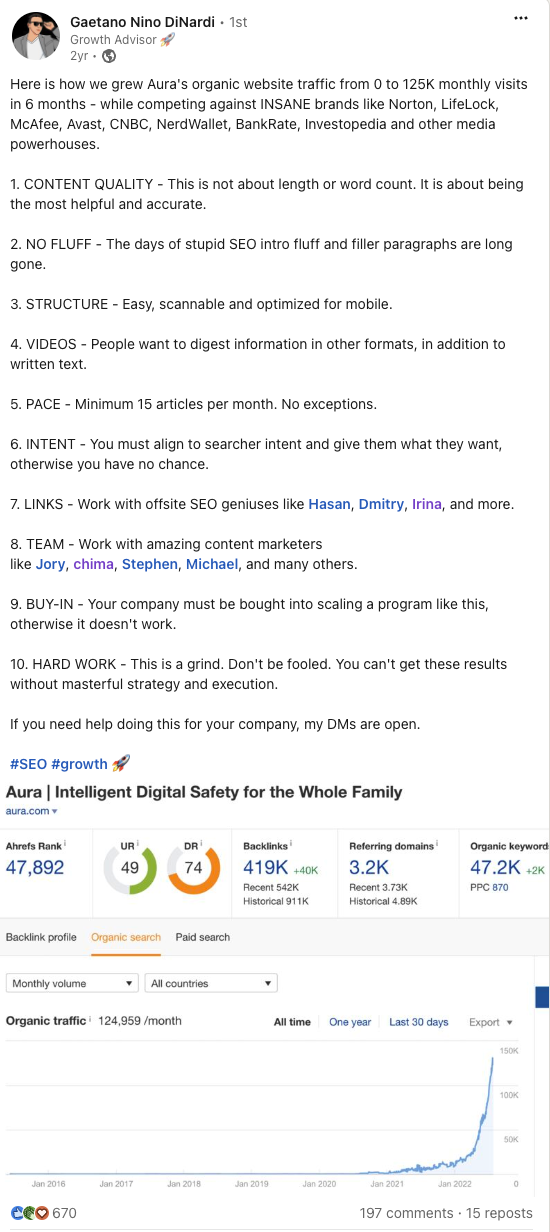
These detailed studies consistently bring in great potential clients — people will often reach out referencing specific cases that mirror their own challenges.
By demonstrating real-world expertise rather than theoretical knowledge, these case studies help establish trust before the first conversation.
7. I offer free resources to add value and increase profile visibility
I regularly share resources that marketing teams can use immediately — the same tools I use with my consulting clients.
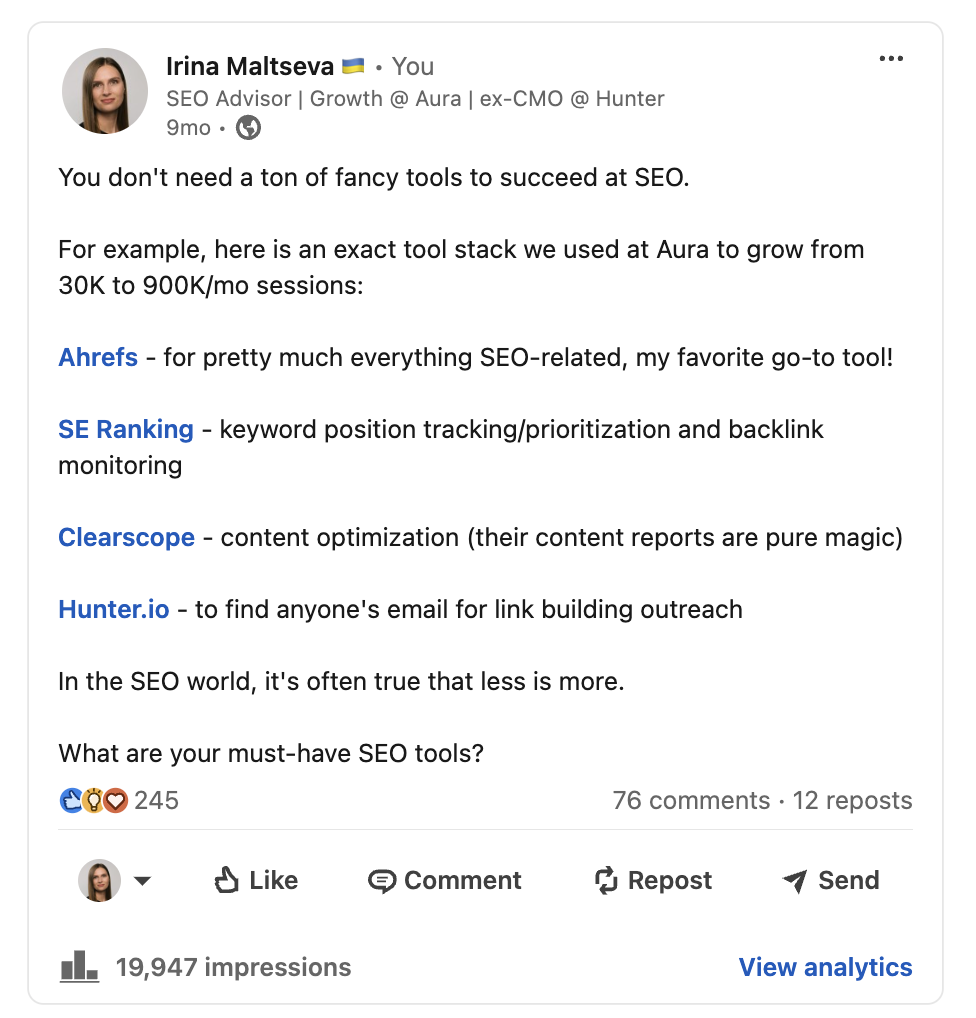
When sharing these tools, I include clear implementation guidelines and real examples of their impact. I make all resources freely available without requiring email signups or other commitments.
This approach consistently generates higher engagement. More importantly, when people successfully use these tools, they often reach out to discuss how I could help implement similar strategies in their businesses, naturally leading to consulting opportunities.
6. I share challenges, setbacks, and learnings, too
I openly share insights from both successes and failures in my consulting work.
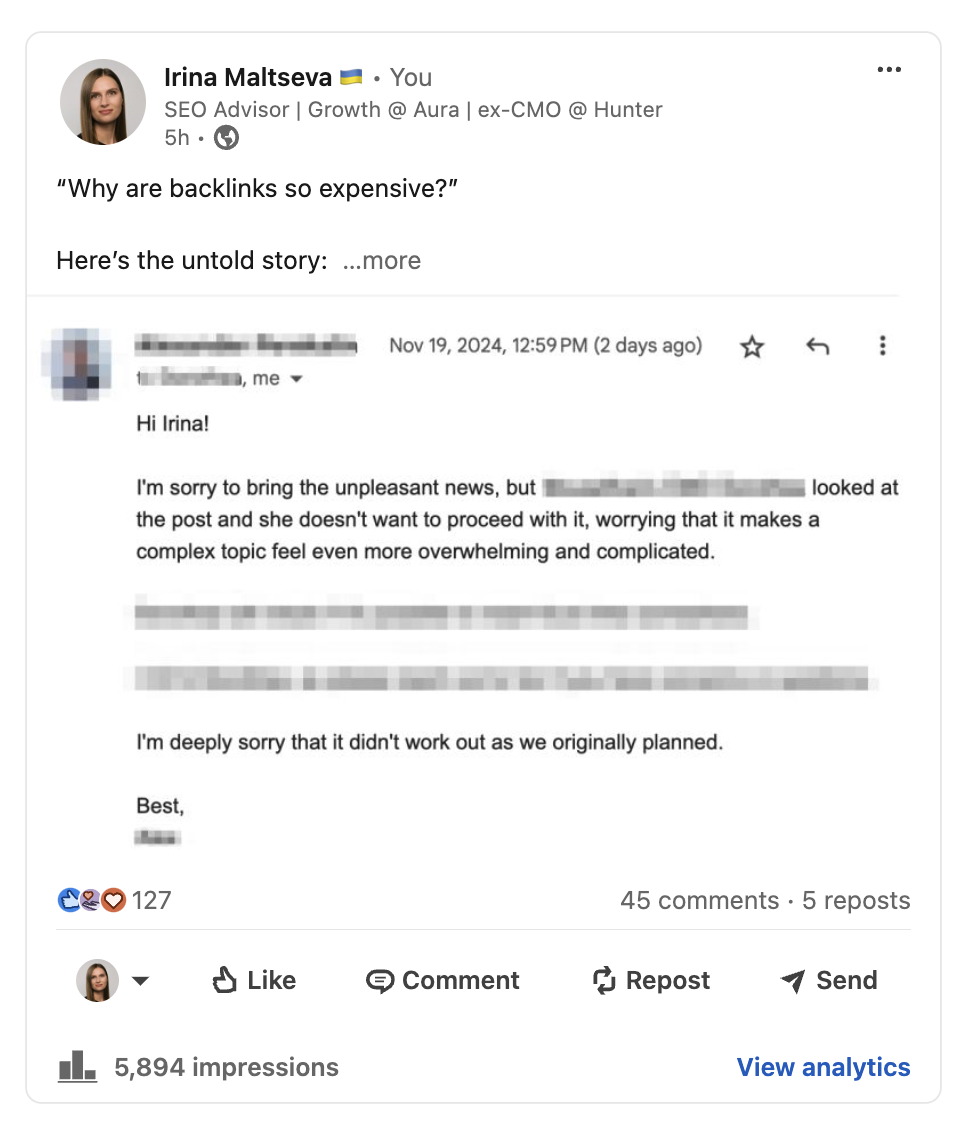
Instead of just highlighting wins, I break down what didn't work and why. Sharing detailed analyses of campaign performance, including metrics, challenges, and strategy adjustments, helps demonstrate real-world expertise.
And funnily enough: These transparent posts consistently resonate more with my audience than polished success stories.
When significant industry changes occur, I share data from actual projects and outline the specific strategies we're testing in response.
This approach of combining industry analysis with practical, tested solutions helps establish credibility while contributing useful knowledge to the marketing community.
7. I crosspost for amplified reach
I regularly publish articles on industry platforms and share them on LinkedIn with additional context and insights specific to my network.
This combination of published work and LinkedIn commentary helps reach new audiences while providing extra value to my audience.
For instance, sharing articles on LinkedIn can spark conversations in the comments, leading to direct engagement with potential clients or collaborators.
Some people, like Gaetano, do it differently. He often repurposes LinkedIn posts into articles for his personal or business blog. This strategy not only saves time but also allows him to validate ideas and see what resonates with his audience before investing in a more detailed piece.
A great example of this in action is Gaetano’s story about why he joined Aura. He initially shared a personal post on LinkedIn about being hacked in Mexico, which generated significant engagement:
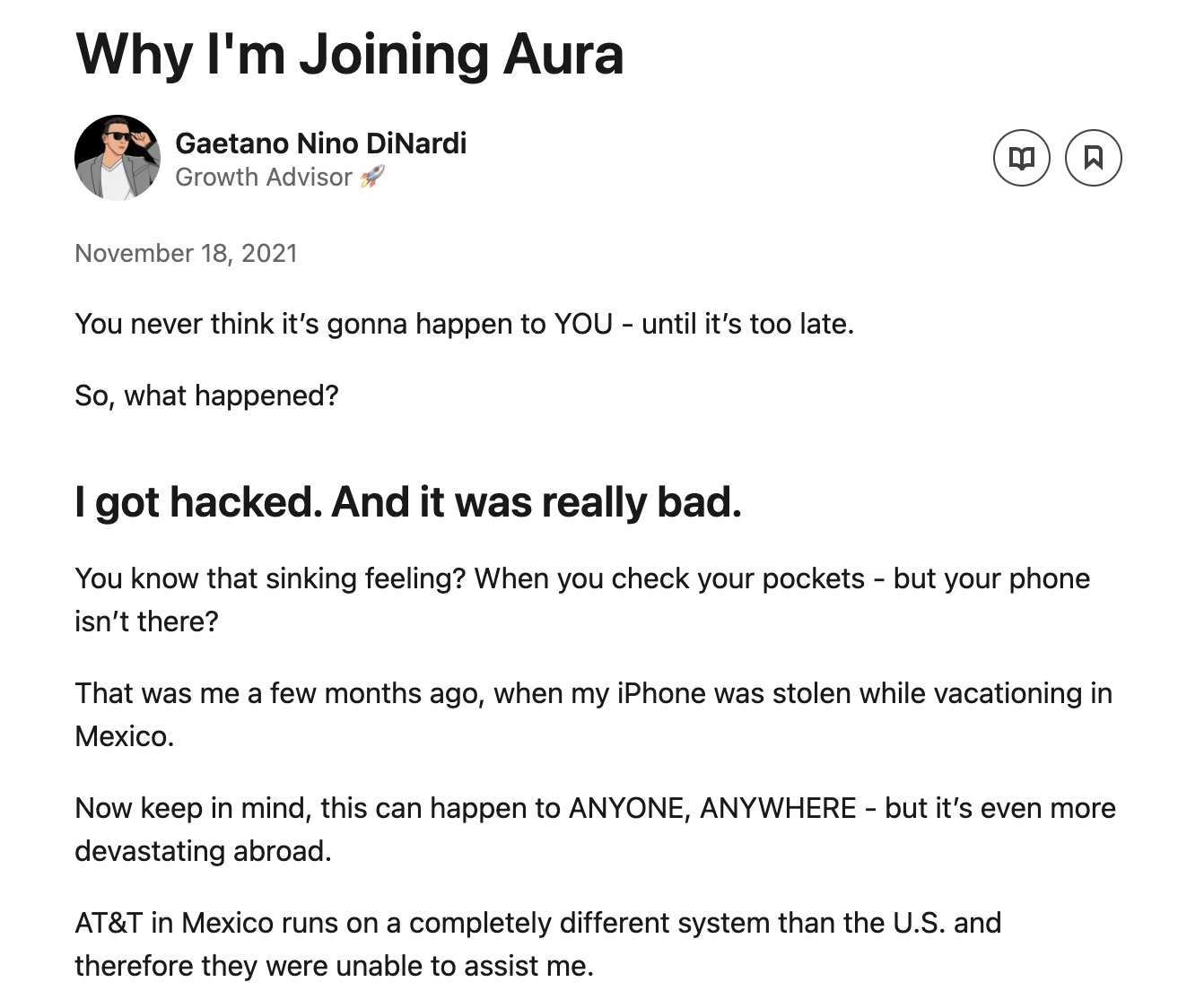
From that post, we developed an actionable guide based on his experience, designed to resonate with others facing similar challenges:

By leveraging the original LinkedIn content and expanding on it, Gaetano not only provided value to his audience but also showcased his expertise, which can attract potential clients who trust his insights and relate to his experiences.
This kind of crossposting doesn’t just amplify reach - it positions you as a thought leader, building trust and authority with audiences who may eventually become clients.
Turn LinkedIn connections into long-term clients
If you start looking at LinkedIn as a business development platform, rather than a professional social media outlet, you’ll start seeing results.
The key is understanding that client relationships develop gradually, and people want to see top-quality, value-packed content. Your audience wants to learn with you — not feel like they’re being sold to.
While a connection might follow your content for months before needing your services, each valuable interaction builds trust and credibility.
Avoid the common mistake of immediately pitching services to new connections.
Instead, engage meaningfully with their content, understand their business challenges, and contribute relevant insights to their discussions. When you do reach out directly, make it specific to their situation or continue a conversation that began through organic engagement.
Your LinkedIn presence should reflect your professional practice.
The same principles that make you successful with clients — delivering value, maintaining high standards, and building trust — apply to your LinkedIn strategy.
This consistent, value-first approach transforms the platform from a simple networking tool into a sustainable source of qualified clients who already understand and trust your expertise.
Try Buffer for free
190,000+ creators, small businesses, and marketers use Buffer to grow their audiences every month.



